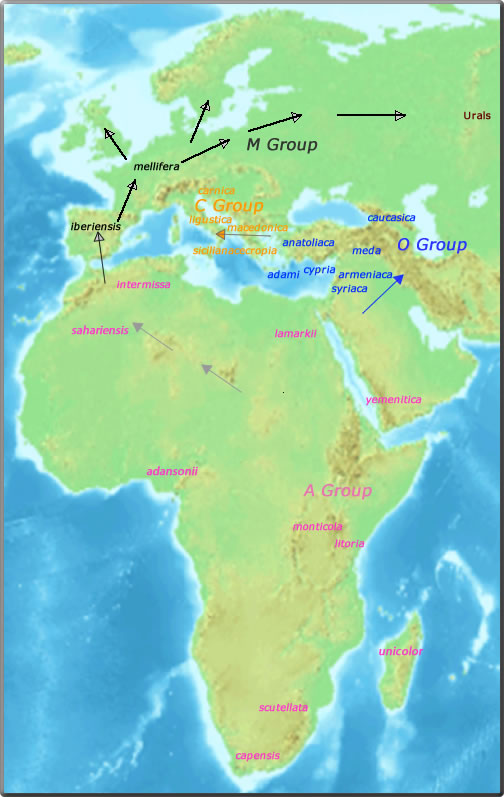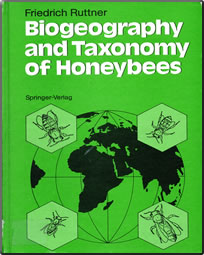Genetics 3F
Origins of Apis mellifera
In his now classic book 'Biogeography and Taxonomy of Honeybees' published in 1988 Prof. Friedrich Ruttner produced a synopsis of all available data on the evolution, morphometric analysis, behaviour, taxonomy, and ecological data of the known geographical variants of Apis mellifera. Ruttner identified 24 sub-species
The Expansion of Apis mellifera
Three apparently conflicting hypotheses have been proposed for the expansion of A. mellifera.
Each is illustrated in a map below.
Three apparently conflicting hypotheses have been proposed for the expansion of A. mellifera.
Each is illustrated in a map below.



The results from mtDNA data
(JM Cornuet and L Garnery 1992) [4]
was used to propose that the expansion of A. mellifera was from an origin in the Middle East.
The A group entered Africa.
The C group entered Europe following a route along the north Mediterranean coast.
Whilst the M group followed a northerly route over the Black Sea and so into northern Europe.
(JM Cornuet and L Garnery 1992) [4]
was used to propose that the expansion of A. mellifera was from an origin in the Middle East.
The A group entered Africa.
The C group entered Europe following a route along the north Mediterranean coast.
Whilst the M group followed a northerly route over the Black Sea and so into northern Europe.
In the 'Thrice Out of Africa (2007)' [6] paper (using SNP's) the authors proposed the origin of A. mellifera was in Africa from where the other groups expanded.
Ruttner on the basis of only morphological data proposed the origin of A. mellifera to be in the Middle East. The M group entered Europe via a route from North Africa through the Iberian peninsular.
The C group took a route along the north Mediterranean coast.
Ruttner's proposal was supported in the paper: From where did the Western honey bee (Apis mellifera) originate? [7] (2012) mention on the previous page.
The C group took a route along the north Mediterranean coast.
Ruttner's proposal was supported in the paper: From where did the Western honey bee (Apis mellifera) originate? [7] (2012) mention on the previous page.
In a more recent research paper (2017)
The Complex Demographic History and Evolutionary Origin of the Western Honey Bee, Apis Mellifera [31]
an evolutionary history for A. mellifera is hypothesized in which the origin of A. mellifera is located in the Middle East or north east Africa, after having diverged from its nearest relatives (cerana) in Asia. However, in contrast to some earlier hypotheses that place the origin of A. mellifera in this region for example (Ruttner 1988; Han et al. 2012; Wallberg et al. 2014), it was found that the M, C, and O lineages are derived from Africa instead of an ancient split between the A and O lineages. The model proposes that, following the origin of A. mellifera, substantial diversification occurred in Africa followed by radiations of the M lineage out of Africa into Europe, and of the C/O lineages back into the Middle East, and then into central Europe leading to the modern European and western Asian populations.
Even more recently in a paper published in late 2021 Thrice out of Asia and the adaptive radiation of the western honey bee the authors found support for an Asian origin of honey bees with at least three expansions leading to African and European lineages. This was achieved by analysing a data set of 251 individual sequenced genomes of A. mellifera representing 18 subspecies. This data was used to reconstruct the origin and pattern of dispersal of honey bees inferring that A. mellifera diverged from cavity nesting bees in southeast Asia. These bees then colonized Europe and Africa from western Asia.
It is interesting to compare this result with the proposal shown in the map on the left above published in 1992. [34]
Even more recently in a paper published in late 2021 Thrice out of Asia and the adaptive radiation of the western honey bee the authors found support for an Asian origin of honey bees with at least three expansions leading to African and European lineages. This was achieved by analysing a data set of 251 individual sequenced genomes of A. mellifera representing 18 subspecies. This data was used to reconstruct the origin and pattern of dispersal of honey bees inferring that A. mellifera diverged from cavity nesting bees in southeast Asia. These bees then colonized Europe and Africa from western Asia.
It is interesting to compare this result with the proposal shown in the map on the left above published in 1992. [34]
4 Groups for Apis mellifera were identified based on their geographical distribution:
A Africa
O Orient: Near East
C Central Mediterranean
M West and North Europe
Ruttner originally proposed the existence of Groups A, C, and M in 1978 and only in 1988 was a fourth branch O proposed.
The distribution of these species is shown on the adjacent map.
Ruttner proposed that north-east Africa was the center of dispersion of these 4 groups. And that the M branch colonized Europe through the Straights of Gibraltar. Ruttner based his hypothesis purely on morphometric analysis before the various DNA methods of identification were introduced.
It is perhaps remarkable how close Ruttner's findings are to those using SNP analysis.
A Africa
O Orient: Near East
C Central Mediterranean
M West and North Europe
Ruttner originally proposed the existence of Groups A, C, and M in 1978 and only in 1988 was a fourth branch O proposed.
The distribution of these species is shown on the adjacent map.
Ruttner proposed that north-east Africa was the center of dispersion of these 4 groups. And that the M branch colonized Europe through the Straights of Gibraltar. Ruttner based his hypothesis purely on morphometric analysis before the various DNA methods of identification were introduced.
It is perhaps remarkable how close Ruttner's findings are to those using SNP analysis.

